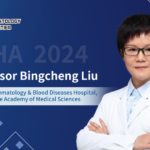
Lymphoma, a common malignant tumor of the hematological system, has always been a focus of research for innovative and optimized treatment strategies. In recent years, with the rise of immunotherapy and targeted therapy, lymphoma treatment strategies are undergoing revolutionary changes. The 29th Annual Meeting of the European Hematology Association (EHA) was grandly held from June 13-16, 2024, in Madrid, Spain. With the rapid development of hematology, Chinese research teams also showcased many innovative treatment plans and clinical research results at this year's EHA conference. At this meeting, Professor Haiwen Huang from The First Affiliated Hospital of Soochow University announced the results of a study on zanubrutinib combined with rituximab and chemotherapy (ZR-chemo) for the treatment of newly diagnosed mantle cell lymphoma. "Oncology Frontier - Hematology Frontier" invited Professor Haiwen Huang to share and interpret the findings of this study.Oncology Frontier – Hematology Frontier: In your study, the combination of zanubrutinib with rituximab-chemotherapy (ZR-chemo) as a first-line treatment showed a 100% objective response rate and a 75.0% complete response rate. Can you further discuss the potential advantages of this combination therapy in improving efficacy compared to traditional treatment methods?
Professor Haiwen Huang:This study targeted newly diagnosed aggressive mantle cell lymphoma (MCL) patients using the zanubrutinib combined with rituximab-chemotherapy (ZR-chemo) regimen. Compared to traditional treatment methods, its advantage lies in the application of the BTK inhibitor zanubrutinib while removing high-dose cytarabine, which helps improve patient tolerance. According to our preliminary study results, this treatment regimen not only shows good tolerability but also significant efficacy, with an objective response rate of 100% and a complete response rate of 75%. Therefore, from this perspective, patients achieve better tolerability while also gaining significant improvements in efficacy.
Oncology Frontier – Hematology Frontier: Your study mentions a 100% bone marrow MRD-negative CR rate after induction therapy. What does this mean clinically? Does an MRD-negative status predict better long-term prognosis for patients, and what guidance does this provide for treatment decisions?
Professor Haiwen Huang:The original intention of this study was to evaluate the efficacy of the combination treatment regimen and explore its potential to replace autologous transplantation as a consolidation treatment method. Based on our preliminary study results, for patients who achieve complete remission after induction therapy and convert their minimal residual disease (MRD) status to negative, previous studies suggest that whether or not they undergo autologous transplantation, their prognosis does not significantly differ. Based on this premise, we no longer consider autologous transplantation as a consolidation treatment during subsequent treatment but instead use BTK inhibitors for maintenance therapy. This approach not only reduces toxic side effects for patients but also improves their quality of life.
Oncology Frontier – Hematology Frontier: How do you plan to expand this study to more comprehensively evaluate the long-term efficacy and safety of the ZR-chemo regimen?
Professor Haiwen Huang:This study is a phase II clinical trial, and we plan to enroll 20 patients. So far, we have enrolled 10 patients at the time of reporting. In fact, we have already enrolled 12-13 patients clinically. Currently, the follow-up time is short, and we hope to further observe whether the MRD-negative status can be sustained after completing the remaining patient enrollment and extending the follow-up period. If the MRD-negative status can be sustained without autologous transplantation, we may consider not using high-dose cytarabine or autologous transplantation for consolidation therapy in future treatment regimens for aggressive mantle cell lymphoma (MCL) patients. This treatment strategy will improve patient acceptance and is expected to further enhance their quality of life.
Oncology Frontier – Hematology Frontier: Finally, which exciting lymphoma research content at this year’s EHA conference are you most interested in? Could you share with us?
Professor Haiwen Huang:This year’s EHA conference continued the development trends in lymphoma research, particularly emphasizing the importance of immunotherapy, including bispecific antibodies and CAR-T therapy. We also witnessed the emergence of new targeted drugs. Overall, for lymphoma patients, we have more and more new treatment options that are expected to extend patient survival. However, we also noticed that these new drugs and targeted treatments, including bispecific antibodies and CAR-T, are quite expensive. Against this backdrop, for Chinese patients, due to economic disparities in China’s development, the accessibility of many new drugs is quite limited. Therefore, should we retain some classic treatment methods? At this conference, we also saw some retrospective studies on classic treatments, which further confirmed their effectiveness. For example, in the treatment of relapsed/refractory follicular lymphoma, autologous transplantation still holds a very important position. Similarly, in treating peripheral T-cell lymphoma, the importance of transplantation cannot be ignored. Therefore, in developing countries, especially for economically disadvantaged patient groups, we still need to emphasize the application of these effective classic treatment regimens in patient treatment.


